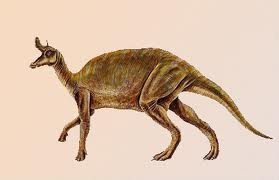Lambeosaurus a hadrosaurid dinosaur lived about 76 to 75 million years ago during the Late Cretaceous Period in the region of North America. This bipedal or quadrupedal, plant-eating dinosaur was recognized for its unique concave cranial crest It is about 15 meters long. The Mexican species L. laticaudus was considered to be one of the highest ornithischians.

Lambeosaurus was tardily described by William Parks in 1923.Twenty years later the first matter was premeditated by Lawrence Lambe. The genus had a difficult taxonomic record since small-bodied cranial hadrosaurid were recognized as infantile and thought to belong to own genera and species. At present, a variety of skulls are allocated to the type species L. lambei and the interpretation shows the age differences and sexual dimorphism between the skulls.
Lambeosaurus directly relates to a species name Corythosaurus, which is found vaguely in older rocks. All had strange crests, which are served for some social functions like noisemaking and identification. Lambeosaurus was pretty parallel to the famous Corythosaurus in everything except in the form of the head decoration. In comparison with Corythosaurus, the crown of Lambeosaurus was moved ahead, and the concave nasal passages are at the front of the crest and stacked vertically.
Lambeosaurus move on two legs as well as with four which is exposed by footprints of related animals. It had an elongated tail stiffened by hardened tendons that is used to prevent it from sagging. The hands consist of four fingers lacking the innermost one of the comprehensive five-fingered tetrapod hand. The second, third, and fourth fingers were clustered together with weary hooves suggesting that the animal could use the hands for sustain. The fifth finger was liberated and used to work on some objects. Each foot of Lambeosaurus had only three central toes.
Lambeosaurus directly relates to a species name Corythosaurus, which is found vaguely in older rocks. All had strange crests, which are served for some social functions like noisemaking and identification. Lambeosaurus was pretty parallel to the famous Corythosaurus in everything except in the form of the head decoration. In comparison with Corythosaurus, the crown of Lambeosaurus was moved ahead, and the concave nasal passages are at the front of the crest and stacked vertically.
Lambeosaurus move on two legs as well as with four which is exposed by footprints of related animals. It had an elongated tail stiffened by hardened tendons that is used to prevent it from sagging. The hands consist of four fingers lacking the innermost one of the comprehensive five-fingered tetrapod hand. The second, third, and fourth fingers were clustered together with weary hooves suggesting that the animal could use the hands for sustain. The fifth finger was liberated and used to work on some objects. Each foot of Lambeosaurus had only three central toes.
Visit: Child Development (8th Edition) by Laura E. Berk

No comments:
Post a Comment